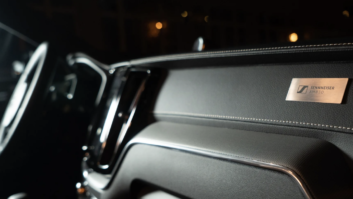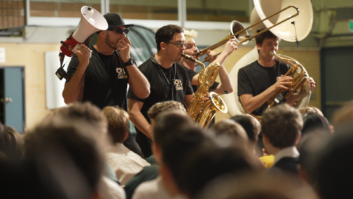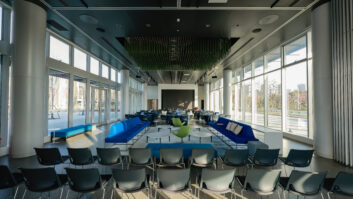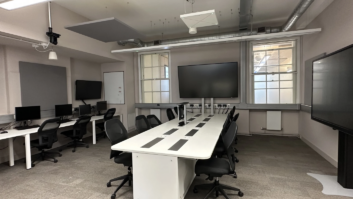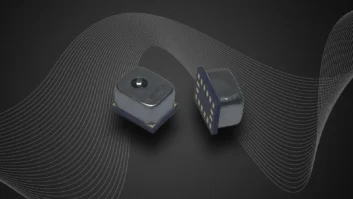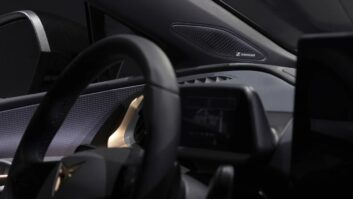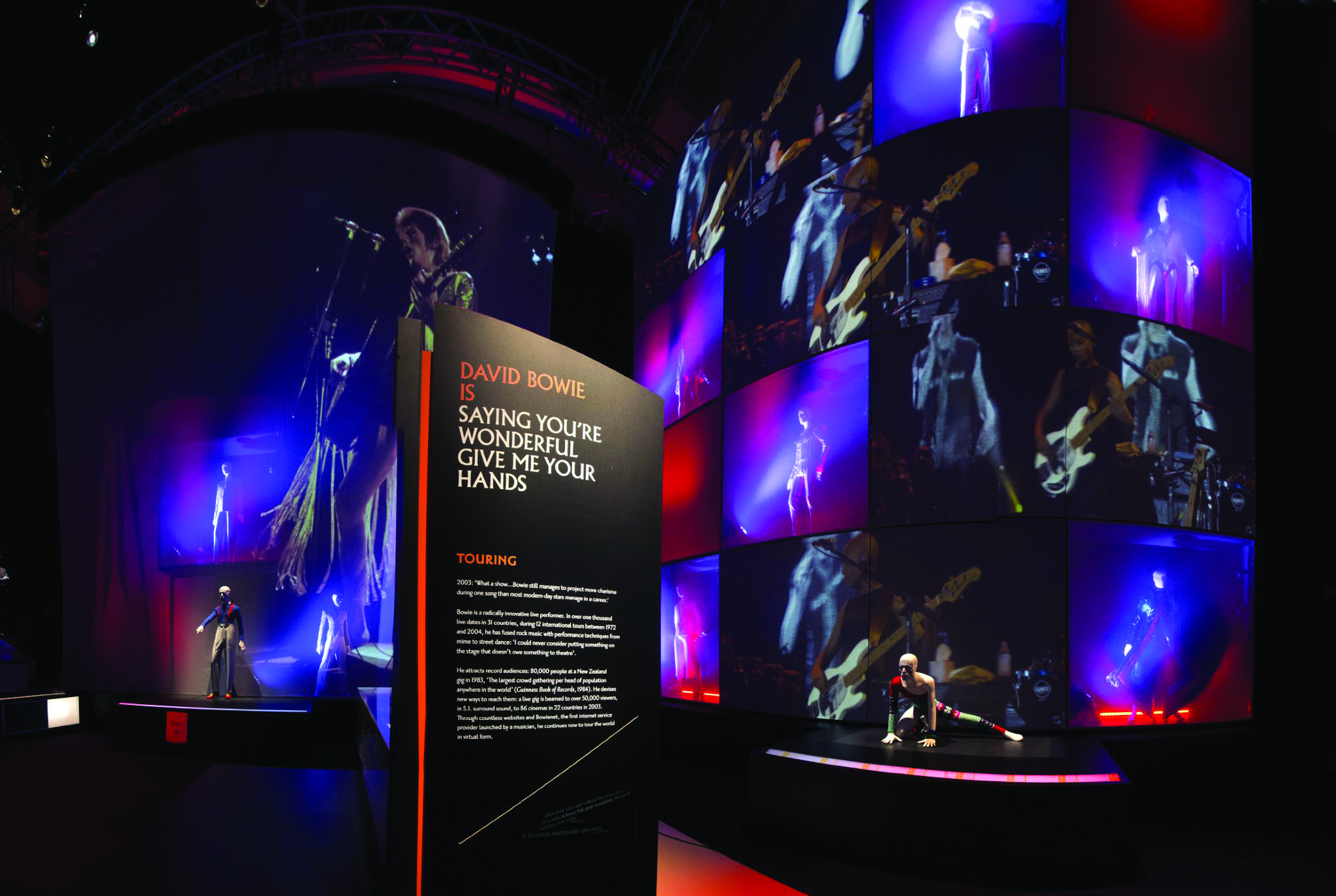
(All pictures: V&A Images)
When it comes to museum exhibits, sound is very much the new kid on the block. Depending on the type of museum you choose to visit, you might see paintings that are many hundreds of years old, tools and artefacts that go back millennia or dinosaur bones and fossils whose ages are measured in millions of years. However, you won’t – you can’t – hear anything dating from before the invention of recorded sound.
“Pre-1877, it’s a silent world – its sound is lost to us historically,” remarks Geoff Marsh, director of the theatre and performance department at London’s Victoria & Albert Museum.
But it’s not only the medium’s relative youth that has meant that sound has been slow to establish itself in museums; there are reasons of practicality. “It was only in the 1990s with the advent of digital technology that it became possible for museums to handle sound cost-effectively,” observes Marsh. He adds that while the use of audio guides has become increasingly common, some visitors remain resistant to them – some for simple technophobic reasons, while others want to follow their own path through the exhibition at their own pace.
“Historically, museums had a monopoly and could do pretty much as they liked – if you wanted to see a Picasso, you had to come to a museum,” he adds. In the internet age, however, visitors are more used to finding information for themselves. “People aren’t interested in being told things. Museums need to think carefully about what they do.”
In recent years, the V&A has become gradually more ambitious with the audio side of its music-related exhibitions. ‘Kylie – The Exhibition’ in 2007, was the second most popular event in the V&A’s history but, admits Marsh, some visitors were disappointed with the quality of the sound there. Later events, such as 2008’s ‘The Story of The Supremes’ and most recently, the Scottish National Portrait Gallery’s ‘The House of Annie Lennox’ (running currently, and co-curated with the V&A) have benefitted from much better audio, he says.
Marsh is one of the curators of ‘David Bowie is’, which has put recorded sound right at the heart of the experience, without having to shepherd its visitors along a set of numbered route markers. The exhibition has been designed by 59 Productions – a video and projection design company that worked on the London 2012 Olympics Opening Ceremony – and exhibition and interior designer Real Studios.
There are a number of considerations when it comes to choosing a musician for a major retrospective like this, says Marsh. David Bowie ticked all the boxes: he has something interesting to say, he has kept a huge quantity of material from throughout his career, and he agreed to give the museum access to any material it wanted to feature. One of the few stipulations was that songs must be played in their entirety.
In fact, in Bowie’s case, the museum was spoiled for choice: “There was so much music, so well known, that there was a space issue.”
But how should the music reach the ears of visitors? “It was either clashing sounds, or people queuing up for headphones on hooks, or this,” says Tom Grosvenor, exhibition co-ordinator at the V&A, of Sennheiser’s guidePORT system of personal receivers and headphones.
Each visitor is given a guidePORT bodypack and headphones on entering the exhibition. As well as a lot of songs by Bowie – from records, music videos or stage and TV performances – there is also audio content from documentaries and other videos (including Bowie’s visit to Andy Warhol’s Factory), plus optional commentaries that can be accessed by pressing a button on the bodypack.
In all, there are over 300 artefacts – including documents, photos, artwork, costumes and videos. The breadth and depth of material is amazing: handwritten lyrics, Bowie’s listing in an actors’ directory from the late ’60s, a booking confirmation letter from Hansa Studios in Berlin, a portable synthesiser given by Brian Eno, a painting of Iggy Pop by Bowie…
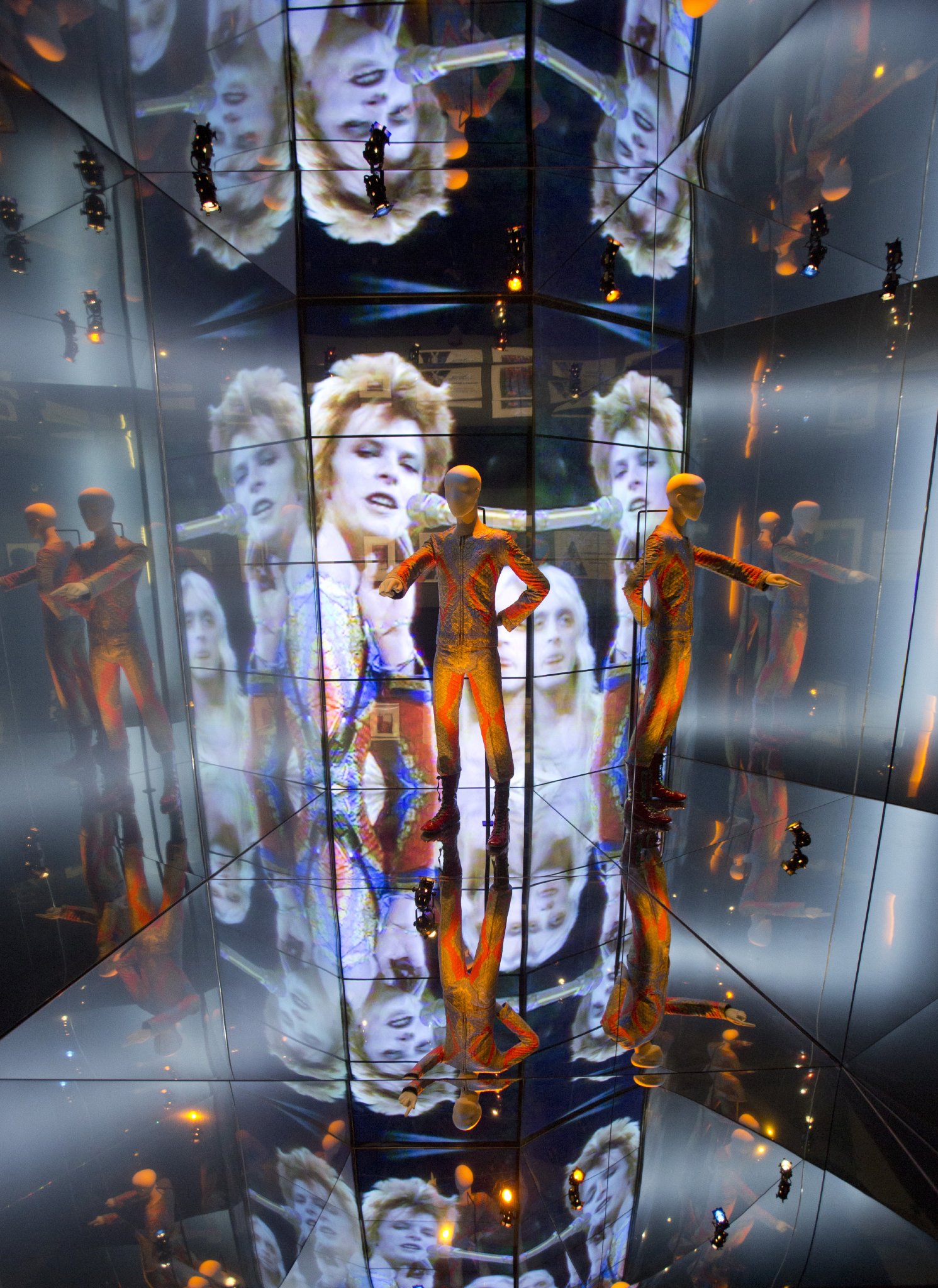
Immersive audio
The user experience is, in Grosvenor’s words, “immersive and seamless”. As one approaches an exhibit, the relevant audio fades in on the headphones. If there is video in the exhibit, the audio is synced to it.
This is achieved by creating audio zones around each exhibit. Music, and lip-synced sound from video clips, is played from media players into 11 twin-cell guidePORT transmitters – located in two control rooms that also house the central guidePORT PC – which send it to antennas in the ceiling and elsewhere. Apart from two messages stored on the bodypacks – a welcome message that plays on arrival and a farewell at the end – all other audio is broadcast to the bodypacks in real time, triggered by visitors approaching exhibits.
The audio zone around each exhibit is bounded by a loop laid in the floor. Hugo Roche, managing director of integrator Sysco AV, which installed all the hardware for the exhibition, explains: “A loop is laid like an induction loop, but it’s not broadcasting the audio – it is purely to trigger an audio event. As you walk in and out of the zone of an exhibit it triggers which part of the broadcast you’re going to pick up.” Small trigger units, placed near the exhibits, known as identifiers, tell the bodypacks which audio stream to receive or play.
“The system needs to work with lots of visitors,” adds Grosvenor. “If the loops are too small, a large number of visitors won’t be able to hear.”
Installing the system was less than straightforward, however, as there turned out to be a lot of other metal in the floor that can interfere with the loop signals – steel-backed wooden tiles, RSJs and a metal pipe.
“There was a lot of modification on-site during the course of the installation to get it all to work as they wanted,” says Roche. This involved not only Sysco AV but also Sennheiser staff including Robert Genereux, technical development director, who is responsible for guidePORT worldwide. In some locations, a loop is not used: the identifiers (which have their own antenna) transmit the audio direct to the bodypacks.
Video is shown on a variety of screens – from small wall-mounted displays to a massive floor-to-ceiling projection towards the end of the exhibition. This is used to show various different performances of Bowie’s song “Heroes” (which has gone, says Marsh, “from a morbid song in Berlin to something approaching a world national anthem”).
Fans who enjoyed the video for the recent comeback single Where Are We Now? will be pleased to see that the puppets that it featured, projected with Bowie’s face, appear among the exhibits. Other projections include a Pepper’s Ghost set-up for the video of Space Oddity, and a small cinema area showcasing some of his work as an actor.
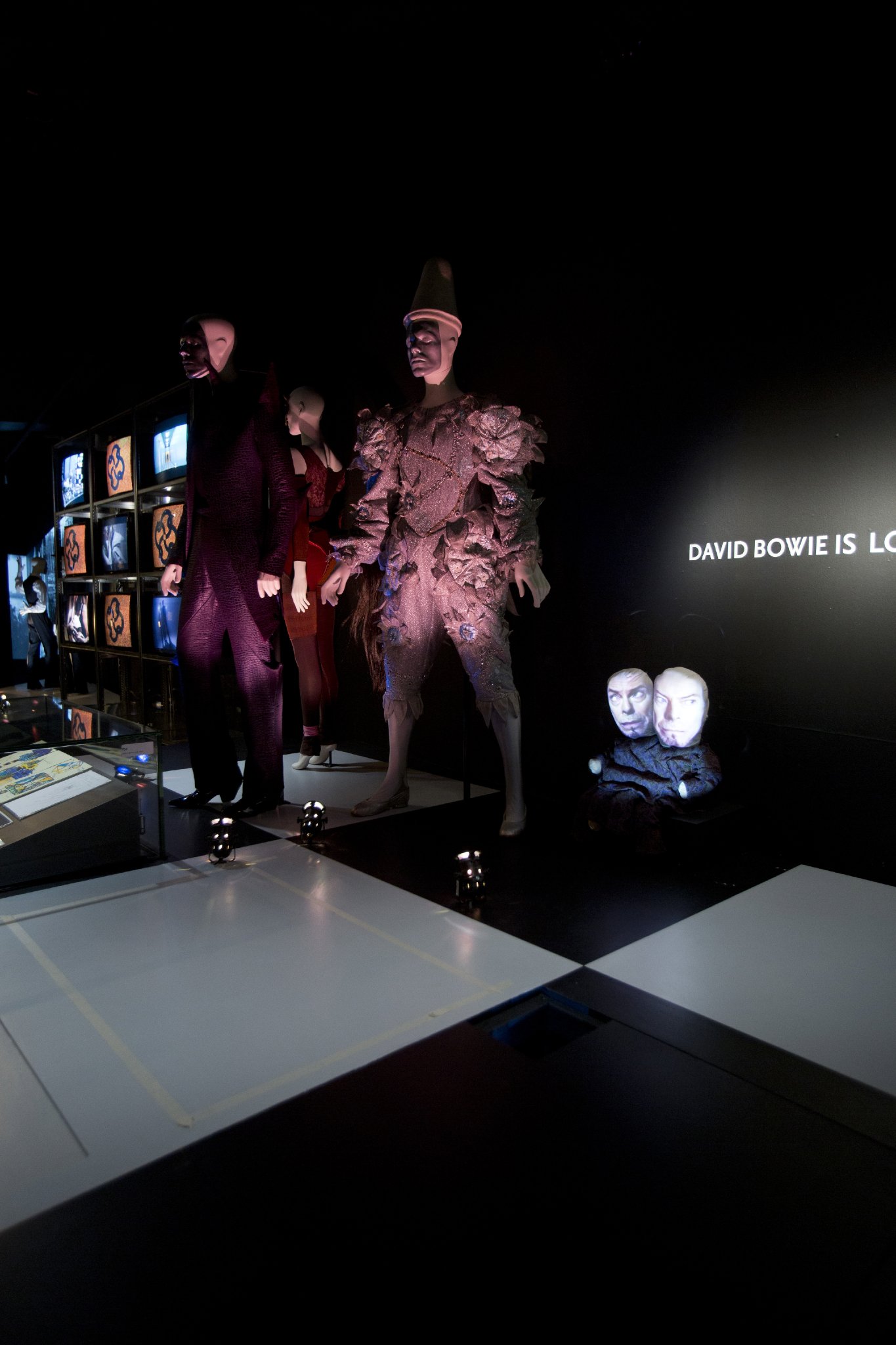
The “Heroes” section features audio played out across a 3D soundscape through hidden Neumann and Klein + Hummel speakers. Because the original mono and stereo audio sources are of varying quality, an upmix algorithm – created by Gregor Zielinksy, international recording applications manager at Sennheiser, was used to create audio suitable for 3D reproduction.
The V&A has a sizeable inventory of audiovisual equipment. Therefore “some of the hardware decisions were based on available stock, some were based on the story that the V&A wanted to tell”, explains Roche.
“Most of the projectors and TVs we had already,” adds Grosvenor. “We want to take this exhibition on a six-venue world tour, and when we do that, we may use other equipment.”
Roche says that the part of the exhibition where the need to use existing inventory had the greatest effect on the installation process was for the large projection, “where we have double-stacked and edge-blended 10 projectiondesign devices in order to achieve the size and brightness of image that 59 Productions was after. A simpler solution would have been to use a brighter projector and only use half the number of them. It presented us with an interesting challenge during the commissioning to pixelmap those projectors that accurately – it was time-consuming.”
Retro look
One somewhat quirky visual attraction is a 3 x 3 array of old CRT televisions – not, one senses, Hugo Roche’s favourite part of the exhibition.
“They had more or less come out of retirement for an exhibition last year, and they must have been at the forefront of someone’s mind at the time.” They were presumably chosen, he says, to lend an element of ’70s or ’80s retro – “it certainly wasn’t because they’d run out of screens. But, boy was it hard work to nurse them into life!”
This is one of the areas of the exhibition that is run by the CueServer master show control. Each CRT screen has its own Brightsign media player, which sits on the main network and plays content according to cues from the CueServer. According to Tom Grosvenor, it would take all day to watch all of this content from beginning to end.
The CueServer also sends cues to the Dataton Watchout servers that drive the main projection, and to the Catalyst servers in the Berlin area, adds Roche.
The most significant issue for Sysco, says Roche, was the time available to do the job. “The installation budget and the commissioning budget were both cut by a week, so we lost two weeks over the normal turnaround period.” Because the event was back-to-back with another AV-heavy show, the company had less than 24 hours to remove the old cabling and install all the new cabling into the exhibition.
With no in-house AV technician, support duties are being fulfilled by Sysco. “We provided tech support during the opening period up to the week after Easter – now we’re on call for any eventualities should they need us,” explains Roche. “We’ve put in place quite a lot of remote diagnostics and remote access so that as much of that can be done offsite as possible.” Unfortunately that doesn’t include the CRTs, which have some rather delicate potentiometers that have required adjustment on site.
Roche had good feelings about the exhibition before it opened. “When I finally saw the whole thing together as one show, I was very impressed and very pleased to have been involved with it. I think the work that 59 did on the media content was excellent, a lot of the exhibits have interesting historical aspects. I think it’s a good show.”
The exhibition was hotly anticipated – it sold 47,000 tickets before it opened on 23 March – the V&A’s highest-ever pre-opening figure. And the exhibition has received excellent reviews – although one influential critic thought that it should be at the O2 rather than the V&A.
“People seem to like it,” says Marsh, “from hardcore fans to people who don’t know much about Bowie. We’ve created an exhibition appropriate to the subject. It’s also the first exhibition in the UK where sound has been so integral to the visitor experience, as one ‘interpretation track’ to mix with other sounds and text.”
The presentation is also appropriate to the demands of the audience. “Within 30 years, all our customers will have been brought up in a world with sound on demand,” says Marsh.
In 2002, Bowie told the New York Times: “Music itself is going to become like running water or electricity.” He was referring to how the internet was poised to revolutionise the music industry – but given the seamless way that audio has been incorporated into the V&A show, he could just as easily have been describing ‘David Bowie is’.
INSTALLED
AUDIO
Sennheiser guidePORT GP EK 3202-5-1 bodypacks
Sennheiser guidePORT GP 3200 IN identifiers
Sennheiser guidePORT GP SR 3200-2 cell transmitters
Sennheiser guidePORT GP AM 3000 antenna modules
Sennheiser guidePORT GP L 3202-10 charging units
Sennheiser PX 100 II dynamic stereo headphones
Audica MICROpoint wall-mounted speakers
Audica MICROzone amplifier/controllers
Neumann KH310 3-way speakers and KH 870 subs
Klein+Hummel IS 153, IS 123 three-way speakers
Klein+Hummel IS Sub 215 subs
KRK Systems Rokit 8 monitor speakers
JoeCo BBP1B BlackBox Players
Motu UltraLite-mk3 audio interfaces
Hive Industries PC Bal Boxes (hum eliminators)
VIDEO
Optoma EH1020 and EH2060 1080p projectors
Panasonic PT-D5000 XGA projectors
Panasonic PT-DZ6700 WUXGA projectors
projectiondesign F32 HD and F32 WUXGA projectors
Vivitek Qumi pocket projectors
Samsung SyncMaster DE40A, DE46A LED displays
Samsung SyncMaster MD32B, UE55A LCD displays
Neovo X-15 15in LCD monitors
Interactive Technologies CueServer
Dataton Watchout V4, V5 media servers
Pro Systems Group Catalyst X4 media servers
BrightSign HD210 media players
Hantarex MGG 28EQ videowall monitors
Adderlink AV200/AV201 extenders (TX/RX)
MauveCom MauD-1 HDBaseT extenders
Wyrestorm EX-1UTP-IR-100 HDMI balun pairs
